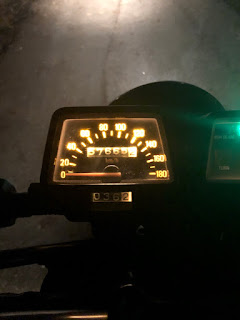There's many good excuses to why I haven't done anything to the old girl in the last year or more like almost two years. Regardless of which, with a bit of shuffling around bikes, I put the Stinkerle (my RD250) in storage and pulled out the turbo and immediately found quite a few flaws that needed to be addressed and some bits that straight away have to be redesigned.
Removed the tank to get an idea of the situation and yep, nobody secretly fixed the flaws the old girl has.
After finding out that the manifold was more hanging in the breeze than sitting properly I removed it to fill the vacuum ports on the inlet rubbers with some liquid gasket.
As I recalled that the last time the oildrain was leaking oil from... quite literally everywhere two hoseclamps were thrown in a sort of band-aid fashion. (Turns out now it also leaks from the turbodrain right at the housing.)
This gash, where the original seat lock sits had to be addressed with some paint, because honestly, why not?
And the rest, as they say, is history - bit of fuel, bit of rejetting and the old Turbo TR1 ran for the first time in ages.
So how to proceed or in other words, the issues so far:
- the manifold is utter crap - too short to fully engage in the rubbers and somewhat twisted. I already have an idea for a much simplified version of this. Also if you go up to the second picture, you will see that the heat distribution in both headers is dramatically different, which means the manifold doesn't work very well that regard either.
- Turbo will move over to the left side of the bike, this will allow me to drain via the engine's oil filler cap and also allow to tuck everything in a lot neater - curious to see, if the oil-line is long enough, pretty much the same goes for the throttle cable
- wastegate actuator needs to be adjusted as it's not closing the wastegate flap strongly enough
- the header of the rear cylinder melts the battery - probably a combination of a heat shield and re-routing the header is due
- find out if I even put in a gasket between the oil-drain of the turbo and the drain-tube, also I have to make a new drain-tube anyway, if I move the turbo to the other side
- the current oildrain will become my oil-filler hole
- an oil-cooler might be a smart move.





















































